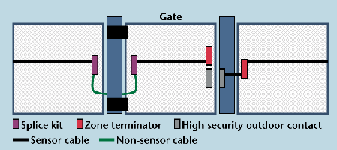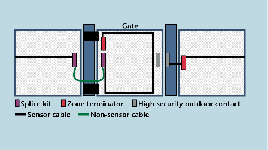1. Which of the following is an example of a buried sensor?
a. Ported coaxial cable
b. Seismic
c. Fiber-optic
d. Magnetic field
e. All of the above
2. An outdoor detection system that utilizes geophones is referred to as a:
a. ported coaxial cable system.
b. seismic system.
c. fiber-optic system.
d. electrostatic field system.
e. None of the above
3. An outdoor detection system that utilizes hair-like glass or plastic strands is referred to as a:
a. ported coaxial cable system.
b. seismic system.
c. fiber-optic system.
d. electrostatic field system.
e. None of the above
4. Which of the following is an example of a line-of-sight detection system?
a. Photoelectric beams
b. Microwave
c. PIR
d. Any of the above
e. None of the above
5. All outdoor detection systems are passive in nature.
a. True
b. False
6. A microwave detection system that utilizes separate transmitters and receivers is called:
a. mono-static.
b. bi-static.
c. transceiver.
d. Any of the above
e. None of the above
7. Buried cable systems provide terrain-following detection.
a. True
b. False
8. Fiber-optic detection systems offer a high immunity to:
a. EMI.
b. RFI.
c. lightning.
d. All of the above
e. None of the above
9. Ported coaxial systems always require the installation of two separate cables, one for transmitting and the other for receiving.
a. True
b. False
10. To provide the maximum detection possible, photoelectric units shall be mounted as close as possible to a fence.
a. True
b. False
11. An outdoor detection system that utilizes parallel field and sense wires is referred to as a:
a. ported coaxial cable system.
b. seismic system.
c. fiber-optic system.
d. electrostatic field system.
e. None of the above
12. All outdoor photoelectric beams may be stacked to provide additional coverage.
a. True
b. False
13. Video motion detection requires the use of digital cameras.
a. True
b. False
14. Ordinary-use magnetic contacts can be used to detect the opening of gates.
a. True
b. False

What’s Wrong with This?
Wally `Larman installed a microphonic intrusion detection system on a fence, including a pedestrian gate, surrounding an outdoor storage facility. Wally checked to ensure that the fence was securely installed, selected the appropriate detection equipment and securely fastened the sensor cable to the fence as shown in this diagram using standard tie wraps. When the system was tested, Wally found that it easily detected an attack on the fence sections, but he was unable to properly detect an attack on the gate. Can you see what Wally did wrong and what he must do to correct the problem?5-Minute Tech Quiz Answers
1. e2. b – A geophone consists of a magnet and a conducting coil, one of which is fixed so it allows the other to vibrate during a disturbance.
3. c
4. d – Each of these detectors requires that the target be within “sight†of the detector.
5. b – Many outdoor systems employ active detection sensors such as microwave, photoelectric, ported coaxial cable, etc.
6. b
7. a – In addition to being terrain-following, buried cable systems also are invisible to a potential intruder, further increasing the level of security.
8. d
9. b – Although many ported or leaky coaxial cable detection systems use separate transmit and receive cables, some systems allow you to use a single cable, thereby reducing installation time and expense.
10. b – Mounting a photoelectric beam very close to a fence can reduce its effectiveness, because a person climbing over the fence may simply jump over the beam.
11. d
12. b – Due to beam spread and other considerations, it is not possible to stack all outdoor photoelectric beams. You should check with your supplier if you need to utilize a stacked beam detector.
13. b
14. b – Magnetic contacts used to detect the opening of outdoor gates should be designed specifically for outdoor use and to resist tampering.



